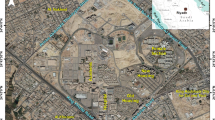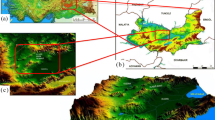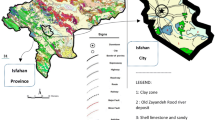Abstract
In this study, soil response analysis in the Peshawar district is undertaken to characterize their local effects using experimental ambient noise measurements. The Nakamura HVSR method has been used to estimate the fundamental frequency of the soils at 75 test site locations, using a 3-component tomograph. Validation of the peak frequency of amplification of soils obtained was carried out using pre-, post-, and main-event data of real earthquake records in Peshawar and at excavated test sites. It has been found that the cultivated areas exhibit a large peak of H/V amplification (4) corresponding to resonance frequencies ranging from 1.3 to 2.1 Hz in contrast to hard-rock sites with low amplification. Some hard-rock sites have a thick cover of soil and a large variation in H/V peak amplification corresponding to frequency ranges from 3.3 to 10.5 Hz. The H/V curves for most of the sites result in a single peak of large amplification and could be associated with sharp discontinuities consistent with a large velocity contrast uni-model of a single layer overlying the bedrock. The site responses of the low fundamental frequencies corresponding to large amplitude are observed to enable identifying cultivated areas that form important inputs in the seismic hazard microzonation of the Peshawar district.










Similar content being viewed by others
Change history
24 February 2021
A Correction to this paper has been published: https://doi.org/10.1007/s12517-021-06708-0
References
Bansal BK, Gupta S (1998) A glance through the seismicity of peninsular India. J Geol Soc India 52:67–80
BCP (2007) Building code of Pakistan seismic provision. In: Ministry of Housing and Works, Pakistan: Islamabad.
Burbank WD, Tahirkhali RA (1985) The magneto stratigraphy, fission track dating and stratific evolution of the Peshawar Intra mountain Basin, Northern Pakistan. Geol Soc Am Bull 96:539–552
Chandra U (1977) Earthquakes of peninsular India: a seismotectonic study. Bull Seismol Soc Am 67:1387–1413
Fah D, Ruttener E, Noack T, Kruspan P (1997) Microzonation of the city of Basel. J Seismology 1:87–102
Field EH, Jacob K (1993) The theoretical response of sedimentary layers to ambient seismic noise. Geo Res Lett 24:2925–2928
GEOPSY (2011) GEOPhysical Signal database for noise arraY processing (GEOPSY) software: an algorithm of the Array and HV plugin Version 2.9.0 (geopsypack-2.5.0), marc@geopsy.org.
Hashash YM, Kim B, Olson SM, Ahmad I (2012) Seismic hazard analysis using discrete faults in Northwestern Pakistan: part I–methodology and evaluation. J Earthq Eng 16(7):963–994
Ibs-von Seht M, Wohlenberg J (1999) Microtremor measurements used to map thickness of soft sediments. Bull Seismol Soc Am 89(1):250–259
Kazmi AH, Jan MQ (1997) Geology and tectonics of Pakistan. Graphic Publishers, Karachi, Pakistan
Kempe DRC, Jan MQ (1980) The Peshawar plain alkaline igneous province, NW Pakistan, Proceedings of International Commit. Geodynamics, Grp 6 Mtg. Peshawar, Nov. 23-29, 1979. Geological Bulletin University of Peshawar (special issue) 13:71–77
Khaliq AH, Waseem M, Khan S, Ahmed W, Khan MA (2018) Probabilistic seismic hazard assessment of Peshawar District, Pakistan. J Earth Sys Sci
Khan S, Khan MA (2016) Mapping sediment thickness of the Islamabad City using empirical relationships: implications for seismic hazards assessment. J Earth Sys Sci 125(3):623–644. https://doi.org/10.1007/s12040-016-0675-0
Khan MA, Abbasi IA, Khattak GA (2002) Geological control on natural hazards: earthquake and mass movement hazards in Pakistan. Geol Bull Univ Peshawar 35:1–8
Khan MA, Aslam M, Hussain A, Ashraf M, Afridi AGK (2006) Geological map of North West Frontier Province, Pakistan (Colored, Scale 1:1,000,000). Geological Survey of Pakistan (Map Series).
Konno K, Ohmachi T (1998) Ground motion characteristics estimated from spectral ratio between horizontal and vertical components of microtremor. Bull Seismol Soc Am 88:228–241
Lachet C, Bard PY (1994) Numerical and theoretical investigations on the possibilities and limitations of Nakamura’s technique. J Phy Earth 42:377–397
Lachet C, Hatzfeld D, Bard PY, Theodulidis N, Papaloannou C, Savvaidis A (1996) Site effects and microzonation in the city of Thessaloniki (Greece). Comparison of different approaches. Bull Seismol Soc Am 86:1692–1703
Lermo J, Chavez-Garcia FJ (1994) Are microtremors useful in site response evaluations? Bull Seismol Soc Am 84:1350–1364
MonaLisa, Khwaja AA, Javed M (2004) Seismic hazard assessment of Islamabad, Pakistan, using deterministic approach. Geol Bull Univ Peshawar 37:199–214
Nakamura Y (1989) A method for dynamic characteristics estimation of subsurface using microtremor on the ground surface. Q Rep Railway Tech Res Inst 30(1):25–33
Nizami MMI (1973) Reconnaissance soil survey of Peshawar Vale (revised). Soil Survey Report of Pakistan. Lahore, Pakistan
Nogoshi M, Igarashi T (1971) On the amplitude characteristics of microtremor (Part 2). J Seismol Soc Japan 24:26–40
Ohmachi T, Nakamura Y, Toshinawa T (1991) Ground motion characteristics in the San Francisco Bay area detected by microtremor measurements. Proceedings of 2nd International Conference on Recent Advance. 11–15 March, St. Louis, Missouri, 1643-1648 (In Geot Earth Eng and Soil Dyn)
Parolai S, Bindi D, Baumbach M, Grosser H, Milkereit C, Karakisa S, Zunbul S (2004) Comparison of different site response estimation techniques using aftershocks of the 1999 Izmit earthquake. Bull Seismol Soc Am 94:1096–1108
Rafiq M, Ahmad I, Tahirkheli T (1983) A geological map of the surroundings of the Peshawar Plain. Geol Bull Univ Peshawar 16
Ravi Kumar M, Bhatia SC (1999) A new seismic hazard map for the Indian plate region under the global seismic hazard assessment program. Curr Sci 77:447–453
Saeed Z, Warnitchai P (2010) Probabilistic seismic hazard maps for Pakistan. 15th World Conference on Earthquake Engineering, Bangkok, Thailand
SESAME (2004) Site effects assessment using ambient excitations, European research project. http://sesame-fp5.obs.ujf-grenoble.fr.
Waseem M, Spacone E, Lai CG (2018) Seismic hazard assessment of northern Pakistan. Nat Hazards 90(2):563–590
Funding
The research described in this paper was financially supported by the National Centre of Excellence in Geology, University of Peshawar.
Author information
Authors and Affiliations
Corresponding author
Additional information
Responsible Editor: Longjun Dong
The original online version of this article was revised: This article has an error that was introduced during the publishing process. In this paper, Fig. 5b is mistakenly identical to Fig. 5a. The correct Fig. 5a, b and its caption are provided here.
Rights and permissions
About this article
Cite this article
Khan, S., Waseem, M. & Jan, S. Site response studies in Peshawar using the Nakamura technique of HVSR. Arab J Geosci 14, 193 (2021). https://doi.org/10.1007/s12517-021-06527-3
Received:
Accepted:
Published:
DOI: https://doi.org/10.1007/s12517-021-06527-3




